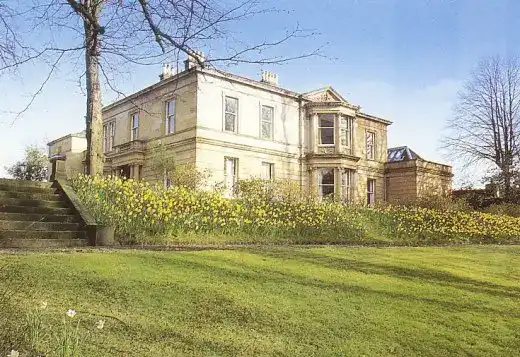Craigie Hall Charles Rennie Mackintosh building, John Keppie Glasgow architecture, Honeyman design Scotland
Craigie Hall Glasgow
Glaswegian Planning Development design by John Keppie, redeveloped by architect Charles Rennie Mackintosh
post updated 15 February 2025
Design: John Keppie
Rework: Charles Rennie Mackintosh
6 Rowan Road, Dumbreck, Glasgow, Strathclyde, Scotland
Bennett Planning Statement
Built in 1872 to a design by John Honeyman and subsequently reworked in part by John Keppie in 1892 it was further reworked by Charles Rennie Mackintosh Architect (CRM) in 1897.The building was designed as a single dwelling and the changes and modification which were added over the years were to meet the changing demands of the owners.
25 Jun 2014
Craigie Hall Glasgow – Dumbreck Housing Development
It was during 1897 that the building underwent the most significant changes in respect of architectural heritage, the changes for which the building is most famous. During this time the fine music room was formed housing the wonderful organ designed by CRM. This is complemented by a fine CRM fireplace on the opposing wall. Whilst the overall building is most attractive, it is fair to say that the buildings grade A listing is down mainly to these and other fittings.
Prior to the building being vacated in, we understand 2009, it operated as a business centre housing mainly professional offices. To accommodate the needs of the business centre, the area immediately around the building was redesigned to provide a high level of car parking. Fortunately the conversion from a residential house to a business centre was carried out in a sympathetic manner with little damage or impact on the interior.
Despite extensive advertising the market displayed no interest in the building, and in 2012 it went to auction and was purchased by the current owner.
Craigie Hall Building, Glasgow
Current position
As stated above, the building has been empty since 2009, Unfortunately, even during the periods of occupation the building was not subject to the necessary repair and maintenance regime so essential in a building of this type. The result is that extensive areas of the building have suffered from water penetration and wet and dry rot. Due to the lack of effective security large areas of lead have been removed from the roof exacerbating the penetration of water.
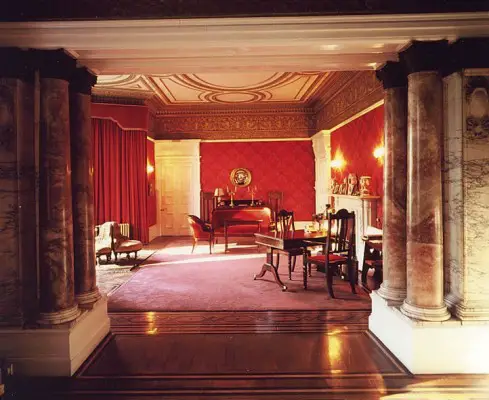
It is to be regretted that one such area is the music room where the dry rot has affected both the fabric of the building but also the organ. It should be noted that many parts of the organ are missing and it would require costly renovation. As a result of all of the above, the building is designated as being at Moderate risk on the “Buildings at Risk Register It goes without saying that if left unattended and without investment that designation would quickly rise to High.
Plans previously provided show the areas of rot and the recommended treatments, though as other areas of the building are uncovered it is expected that more of the building will have succumbed to rot infestation.
The cost of remedying the rot alone has been put at around £150,000.
Externally the building is generally sound though there are large areas of the roof which require to be reslated and areas where failing rainwater goods have caused damp staining on the walls.
6 Rowan Road, Dumbreck Property Proposal
Proposal
The new owners are keen to restore the building to its original use, as a dwelling. The attached plans illustrate what is being proposed and it is apparent that the aim is to have a minimal impact on the existing layout and distribution of rooms.
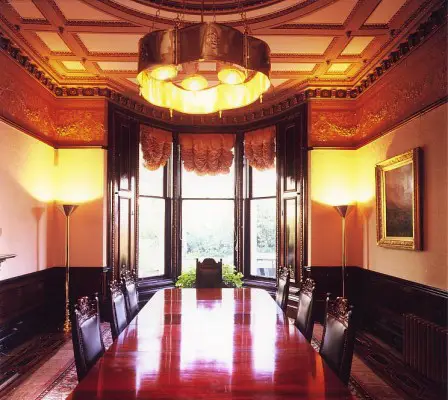
It is intended that the main building be divided into two houses , with the outbuilding being converted into a third dwelling.
It is particularly interesting that whilst there will be three separate dwellings, they will remain in single ownership with a single title. The dwellings will be occupied by members of the one family. This is a most positive position in terms of securing the building and safeguarding the quality interiors. Given the depressed nature of the market, particularly for large high maintenance buildings such as this, it is most fortunate that a buyer emerged at all, but it is even more fortuitous that one has emerged who is willing to spend substantial sums of money on the building and to occupy it as private dwellings.
In seeking to deliver a layout which respects the existing layout but at the same time responds to modem day requirements, it has proven necessary to locate the kitchen in the main dwelling house, to the existing music room. This step was not taken lightly but arose from a critical and robust examination of all possible locations for this activity. Numerous other layouts were examined but due to the sprawling nature of the floorplan and the distribution of the main rooms, all of which are on main elevations, there is no where else that it can be located effectively.
If the building is to be restored then it has to meet the requirements and aspirations of the new owners, and whilst respect for the buildings heritage is vital, unless it can be made to function as dwellings , it will not be restored.
Given that this is the site of the CRM interior this could be a major problem. However, the extensive rot in this room, in particular behind the fitted CRM organ, will require that the organ be dismantled and removed from the building to allow the rot eradication works to take place. It is suggested therefore that rather than reinstate the organ, which would require substantial renovation works before it could be placed anywhere, that it may be worth considering moving it permanently to another venue where it could be viewed by the public and possibly restored so that it can also be enjoyed as a musical instrument.
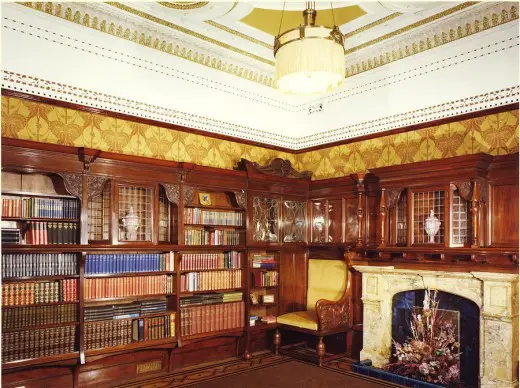
Possible venues could include the Art School, the House for and Art Lover, and Kelvingrove Art Galleries and Museum. A building with an association to CRM would, it is felt be most appropriate.
On balance it is felt that this is the most desirable option in that it will permit the existing building to be returned to residential use, a fact which will be greatly prejudiced if the organ is to remain in its present location. Given the almost total lack of interest in the building from the market, it is likely that the building would remain empty and deteriorate further with the possible loss of the CRM interiors. It is also worth recording that the organ made a positive statement in the room for which it was intended, le the music room.
Once this use is lost, the raisond’etre for it remaining in that location is perhaps less defensible. Far better that it is seen and enjoyed by the public than it languish in a rapidly deteriorating building, where it may be irrevocably damaged by water and rot infestation. Unless this problem can be resolved to the satisfaction of all, but particularly the owners, the restoration may founder and the property be placed back on the market. In the event that the organ can be removed from the building and relocated elsewhere, the owners have generously agreed to gift the organ to the new owner with a proviso that a small plaque intimating that the family have donated it, be displayed.
With the exception of the organ, the proposed design does not affect any other fittings within the building. The CRM fireplace in the music room would remain in situ and make a fine feature in the proposed kitchen.
Externally there will be few changes to the existing facades The main exception would be to the detached outbuilding where it is proposed three feature dormers be added to the roof. The building has an oddly shaped footprint, having a kink halfway along its length and has fairly restricted dimensions.
The proposed dormers would be looking into the small existing courtyard and would be constructed with the same palette of materials as the main dwelling. The roof is currently covered in felt, but this would be reconstructed in slate. The attached sketch illustrates what is being proposed. These dormers would permit the use of the roof space and allow for a more acceptable dwelling to be formed. It should be noted that numerous adjacent dwellings have dormers.
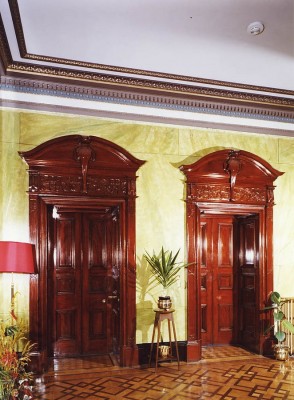
The other change would be to reinstate a small courtyard on the elevation facing onto the detached building. It is understood that this courtyard may have been roofed over as part of the changes that were made in 1892. The fact that this was added is evidenced in the fact that the new wall head crudely abuts and obscures the stone scroll on the main building. In removing this infill the original scroll will be revealed.
The resultant courtyard will provide a delightful courtyard for the sole use of the occupants of the smaller of the dwellings within the main building.
6 Rowan Road, Dumbreck Property – Conclusion
The existing building represents a good example of the architecture of the late 1800’s, and whilst it is of itself not an outstanding example it is a well mannered and attractive structure. The fact that some time after it was constructed , Charles Rennie Mackintosh was commissioned to carry out some internal design work, particularly in creating the music room, elevates this building to one of greater import and accordingly it’s status as a Grade A Listed Building.
The building has enjoyed a chequered past though thankfully none of the previous uses has materially affected the interior or the exterior in any meaningful way.
Notwithstanding, since it was last occupied as a Business Centre, the building has remained empty and despite extensive advertising failed to attract any substantive interest and was therefore put to auction.
The new owners are particularly keen to restore the property as far as is practical and financially viable. Currently the anticipated cost of the works is in excess of £500,000. It is most fortunate that the new owners wish to return the building to residential use, and I believe even more fortunate that they will occupy it as family homes Their purchase of the property was not simply an attempt to seek investment value by a quick refurbishment of essential elements and then a resale. The property was purchased to be a home.
Despite its grand design, the internal layout and the distribution of rooms is not conducive to modern living and whilst every attempt has been made to minimise the impact of any change, this has not been possible and unfortunately the music room cannot be retained.
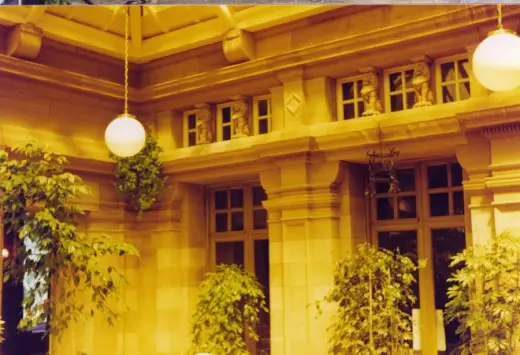
Given the extent of rot and water damage to the building it will be necessary to remove large areas of ceiling, mouldings and walls in order to affect repairs.
In the music room the rot behind the organ is considerable and the organ which itself is in need of considerable restoration will require to be removed in order to eradicate the rot. It is suggested that once removed, it be relocated in another venue where it can be viewed by the public and possibly heard by the public.
It is appreciated that removing the organ is a major issue and not one which can be entertained lightly. However, apart from the new owner there was no other interest in the building and the hard fact remains that without an owner prepared to invest in the building, not only will the organ succumb to the elements, but the building itself will be lost.
It is felt that the package of refurbishments proposed by the owners and the gifting of the organ to a new home, is a price worth paying for the restoration of this building.
This is a large and imposing building which as a result of a lax or non-existent maintenance regime in the past is now displaying advanced signs of rot. We have, in the form of the new owners, the opportunity to refurbish the building and save it for the enjoyment of future generations. The fact that listed elements within the building will be affected is most unfortunate, but it is felt that the relocation of these elements to a new home is a price worth paying for the restoration of the building. It would have been wonderful had this situation not arisen, but in the current market it is felt that a degree of pragmatism is necessary and the suggested course of action will save not only the organ but the building. With no other options, the alternative does not bear consideration.
In pursuing the removal of the organ, the Heritage Section of City Council, the Charles Rennie Mackintosh Society, Historic Scotland, and The Royal Commission on the Ancient and Historic Monuments of Scotland have all been actively involved. The Royal Commission had the building photographically recorded, so that there is now a full and accurate record of both the interior and exterior of the building.
There is now an acceptance that the removal of the organ to another home, while regrettable, is permissible and the challenge now is for that new home to be identified In the meantime and in order not to hold back the essential ongoing repair and restoration works, it has been agreed that in the absence of a new home being identified at this time,that the organ be removed under professional supervision and moved to a place of storage where it can be safely stored and possible restored.
Having regard to all of the foregoing it is hoped that the Council will support this ambitious and worthwhile project and grant consent to this application.
Craigie Hall Planning Statement
Craigie Hall Planning Statement from from Bennett
Graham Roxburgh:
“I was fortunate enough to acquire and restore the then semi-derelict Craigie Hall to become my firm’s head office for the 24 years up to my retirement in 2004. During that period, all work on the building was carefully carried out with the maximum respect for its A-listed status, and in consultation with the City Planners. It was voluntarily and regularly opened to the public with the benefit of expert guided tours. I can therefore reasonably claim to have an exceptional understanding of the potential of Craigie Hall to remain a self funding and open asset to the City of Glasgow. The attached file “Craigie Hall Glasgow” is submitted, in order to share a more rounded picture than is generally available, of this remarkable building.
Sadly, a decade on, Craigie Hall has suffered neglect and deterioration in recent years, to the extent of being placed on the Register of “Buildings at Risk”. And it is now the subject of the above new planning application which includes a proposed division of the main building into two apartments. The application further asserts that the Mackintosh Organ must be removed “to a place of safety”, a questionable step, which seems designed to downgrade the Music Room for conversion to a domestic kitchen (for which no detail is provided). No mention is made of the stained glass window behind the Organ, an obvious component of its design.
In this way, the Mackintosh-inspired composition of Entrance Hall/Music Room/Conservatory would be lost for ever.
The planning application appears to deny the A-listed status of Craigie Hall, which is nowhere referred to in the text nor within the very rudimentary drawings supplied. The absence of any reference to the listed fittings and the “remarkably complete interiors” implies that no account has been taken of these, which include The Mackintosh Library and all of the extensive design features described in the attached “Craigie Hall Glasgow” file.
It is said that the Organ might be donated to Kelvingrove Gallery where it would obviously be out of scale, out of context and dwarfed by the huge presence of the organ already in place there. This would not only rip the heart out of Craigie Hall, it would destroy the essential character of this veritable treasure trove of Mackintosh’s design development on his path to international acclaim.
That such proposals should be considered for approval by the Council in the same month as the tragic events occurring to the School of Art would be unthinkable.
What is needed is a recognition that a local cluster of cultural assets is in the making, with
- House for an Art Lover
- Bellahouston Art Park
- Local Heritage Centre
- Pavilion Art Studio (opening 4 July 2014)
- And to complete the related cluster, a restored, protected and accessible Craigie Hall
In other words “An achievable vision for the next Century” largely inspired by Mackintosh himself!
The City of Glasgow must not compromise the A-listing of Craigie Hall and are urged to refuse this Application.”
Craigie Hall Planning Application Appeal Letter from Graham Roxburgh
6 Rowan Road, Dumbreck, Glasgow, Strathclyde, southwest Scotland, UK
+++
Glasgow Buildings by Rennie Mackintosh Architect
Glasgow Building Designs by Rennie Mackintosh Architect – key selection below:
House for an Art Lover, Bellahouston Park, south west of Glasgow city centre
Hill House, Helensburgh, northwest of Glasgow
Glasgow Building Designs
Contemporary Glasgow Property Designs – recent Strathclyde architectural selection below:
Comments / photos for the Craigie Hall Building design by John Keppie, redeveloped by architect Charles Rennie Mackintosh, page welcome.
